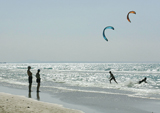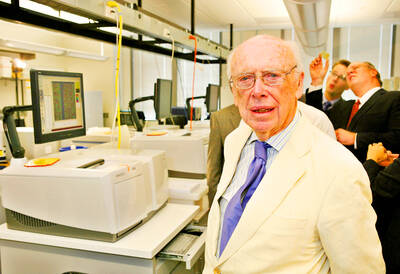Behind the mangroves that skirt the blue waters of Cuba’s Bay of Cardenas, a 1,500-slip marina is taking shape as the island’s tourism industry braces for what could be its biggest challenge yet.
The Americans are coming — or they may be, soon.
Rock jetties jut out into the bay and beyond them a plot of land the size of several football fields is taking shape, reclaimed from the water as part of a big new marina project at Varadero, a beach resort 130km east of Havana.

PHOTO: REUTERS
“The Americans will come here in their yachts and they’ll put them in the marina,” said a security guard, gesturing to the earth-moving and sand-dredging behind the mangroves.
For most of the time since former Cuban president Fidel Castro’s 1959 revolution, Americans have been prohibited by their own laws from traveling to the Caribbean island under a 47-year-old US trade embargo.
But that may change. Legislation to free travel by Americans to Cuba is pending in the US Congress, and backers expect it could be approved in what they see as a developing thaw in US-Cuba relations under US President Barack Obama.
“If the travel ban is lifted, you’ll probably see hundreds, hundreds of American yachtsmen going to Cuba the next day,” said Timothy Ashby, a former US Commerce Department official who studies Cuban commercial issues.
Cuba’s government and people have been anticipating this moment for a long time, but questions about their readiness for an onslaught of visitors are being raised.
The doubts focus on the capacity and quality of Cuba’s tourist infrastructure, but also on possible political effects on an island that has resisted US influence for 50 years.
After years of animosity with the US, Cuban leaders do not like to say that developments such as the Varadero marina, and other big golf and leisure projects, are being built with the US market in mind.
The official line is that Cuba is preparing for visitors from the whole world and if that includes Americans, so be it.
But the US is the natural market for Cuba, whose economy is reeling from the damage inflicted by three hurricanes last year and the ongoing global financial crisis.
A study for the IMF estimated that as many as 3.5 million Americans could visit Cuba annually if the travel ban was lifted.
But travel experts say 500,000 is a more likely maximum the Cuban government would allow in the early years because it does not have enough facilities for more.
“Cuba is ready to absorb another half million visitors a year, but not another million, just because of hotel capacity,” said a foreign businessman in Cuba’s travel industry.
“I’m sure they will try to control as much as they can in order to avoid a boom that nobody can control. Every country in the world would try to do the same,” he said.
One of Cuba’s biggest sources of cash in recent years has been foreign tourism, which brought in US$2.5 billion in revenues last year.
Government statistics show Cuba had about 55,000 hotel rooms in 2007, the last year for which figures are available. At least 10,000 more are under construction, and others are on the drawing boards.
Experts say Cuba will need more four and five-star hotels for Americans, but also more and better restaurants, shops, rental cars and other tourist amenities.
Before Castro took power on Jan. 1, 1959, in a guerrilla uprising, Cuba was a US playground where Americans swilled booze during Prohibition and gambled and partied the night away in Mafia-built casinos and nightclubs in the 1950s.
Opponents of the Cuba embargo hope more visitors could open up future opportunities for US investors in a Cuban market now dominated by Europeans and Canadians.
Because of its proximity, travel experts say it is inevitable the US will one day dominate Cuba tourism again. Within 10 years, said one industry source, perhaps 70 percent of the island’s visitors will be American or Canadian.
When that happens, said Nigel Hunt, head of Cubaism Ltd, an Internet travel sales site, Europeans who make up about 40 percent of Cuba tourists may go elsewhere.
“If Cuba becomes Americanized, it would probably be less attractive to Europeans ... That’s what makes Cuba interesting, modern American culture is not so pervasive here,” he said.
The possible “Americanization” of Cuba is a selling point in Washington for lifting the travel ban. Supporters say the more Americans who visit the island, the more pressure there will be for an economic and political opening on the island.
While Cuba’s leaders may fret over the prospect of large numbers of Americans arriving, ordinary people in Varadero who depend on tourism for a living seem much less worried.
“Not one person here has anything against the Americans,” said hotel cook and taxi driver Jorge Mendives.
“Let them come to Varadero in their boats or whatever because for us the Americans mean one thing — more money.”

James Watson — the Nobel laureate co-credited with the pivotal discovery of DNA’s double-helix structure, but whose career was later tainted by his repeated racist remarks — has died, his former lab said on Friday. He was 97. The eminent biologist died on Thursday in hospice care on Long Island in New York, announced the Cold Spring Harbor Laboratory, where he was based for much of his career. Watson became among the 20th century’s most storied scientists for his 1953 breakthrough discovery of the double helix with researcher partner Francis Crick. Along with Crick and Maurice Wilkins, he shared the

OUTRAGE: The former strongman was accused of corruption and responsibility for the killings of hundreds of thousands of political opponents during his time in office Indonesia yesterday awarded the title of national hero to late president Suharto, provoking outrage from rights groups who said the move was an attempt to whitewash decades of human rights abuses and corruption that took place during his 32 years in power. Suharto was a US ally during the Cold War who presided over decades of authoritarian rule, during which up to 1 million political opponents were killed, until he was toppled by protests in 1998. He was one of 10 people recognized by Indonesian President Prabowo Subianto in a televised ceremony held at the presidential palace in Jakarta to mark National

US President Donald Trump handed Hungarian Prime Minister Viktor Orban a one-year exemption from sanctions for buying Russian oil and gas after the close right-wing allies held a chummy White House meeting on Friday. Trump slapped sanctions on Moscow’s two largest oil companies last month after losing patience with Russian President Vladimir Putin over his refusal to end the nearly four-year-old invasion of Ukraine. However, while Trump has pushed other European countries to stop buying oil that he says funds Moscow’s war machine, Orban used his first trip to the White House since Trump’s return to power to push for

LANDMARK: After first meeting Trump in Riyadh in May, al-Sharaa’s visit to the White House today would be the first by a Syrian leader since the country’s independence Syrian President Ahmed al-Sharaa arrived in the US on Saturday for a landmark official visit, his country’s state news agency SANA reported, a day after Washington removed him from a terrorism blacklist. Sharaa, whose rebel forces ousted long-time former Syrian president Bashar al-Assad late last year, is due to meet US President Donald Trump at the White House today. It is the first such visit by a Syrian president since the country’s independence in 1946, according to analysts. The interim leader met Trump for the first time in Riyadh during the US president’s regional tour in May. US envoy to Syria Tom Barrack earlier